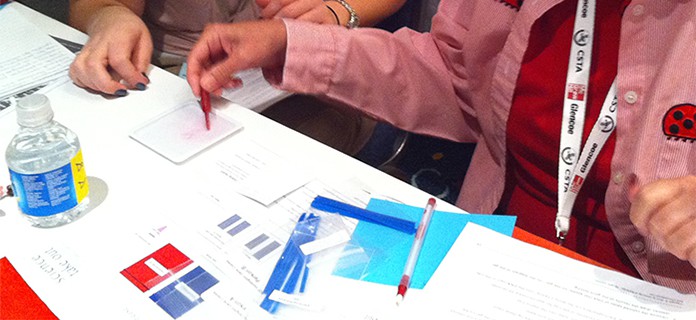

- Shrinking budget?
- Limited access to lab facilities and equipment?
While we hope that you buy and try Science Take-Out kits, we also want to encourage you to learn from our kits and apply what you learn to creating your own lab activities.
Here are some suggestions for how to use simulations to create your own low-budget, hands-on labs.
Simulate – it’s the thinking that counts
There are many benefits of using simulations of laboratory research procedures and medical tests. Simulated wet-lab activities:
- Do not require expensive laboratory equipment
- Use inexpensive reagents that have an extended shelf-life and do not require special storage
- Can be used in both classroom and laboratory settings.
- Can be completed in less time than authentic lab experiences.

Go small-scale
Adopt small-scale (also referred to as microscale) chemistry techniques that reduce chemical risks, waste disposal, and the costs of supplies. Use small quantities of reagents and inexpensive, reusable plastic labware such as microtubes, condiment cups and droppers.

Label for reuse
Save time and money when using materials for multiple lab classes by labeling plastic tubes and droppers so that they can be refilled and reused. Labeled tubes can be refilled and used in future years. Clean up is simplified since you do not need to wash tubes and droppers. Simply squirt out the contents of droppers before storing them.
Use inexpensive plastic measuring supplies.

Graduated droppers and inexpensive medicine cups or graduated plastic cups can be substituted for pipettes and expensive graduated cylinders.

Use printed transparency sheets
Printed clear plastic transparency sheets can be used as an inexpensive substitute for well plates or test tubes. They can easily be rinsed and reused for multiple classes.

Use pH buffer and indicator for simulated laboratory tests
Simulate biological samples (such as “patient blood” or “urine”) by using pH buffer solutions tinted with food coloring. Use pH test paper or pH indicator solutions (such as bromothymol blue, methyl red, phenolphthalein, and red cabbage extract) to simulate laboratory testing solutions. Create customized color charts for the specific buffer/indicator combination.

Use chemical reactions that precipitate or fizz
A saturated calcium chloride solution will form a white precipitate when mixed with a saturated sodium bicarbonate (baking soda) solution. This can be used to simulate antibody-antigen reactions.
Mix baking soda and vinegar to produce a fizzing reaction that could simulate enzyme or chemical activity.
Use card stock spotted with phenolphthalein

Simulate microarrays, electrophoresis gels, or dipstick tests by printing on card stock. Use a cotton swab to apply spots of 1% phenolphthalein to the card stock and let it dry. Applying drops of a basic solution (such as pH 10 buffer or a dilute solution of household ammonia) to the spotted cardstock will result in pink spots.

A safety note
Even though the amounts of chemicals used in laboratory simulations are small, it is important that students follow safe laboratory practices such as wearing safety goggles, reporting all spills immediately, and not tasting or smelling any of the chemicals. Students should be warned that all chemicals used in these experiments are potentially hazardous and that the droppers are not to be used as small-scale “squirt guns.”
Try, and then apply what you learn
We encourage you to try several Science Take-Out kits that illustrate simulated lab tests and then apply what you learn to create your own laboratory simulation activities.
- Diagnosing Diabetes
- Kidney Donor
- Flower Forensics
- Testing for Genetic Disorders that Cause Brain Damage
- Kidnapped